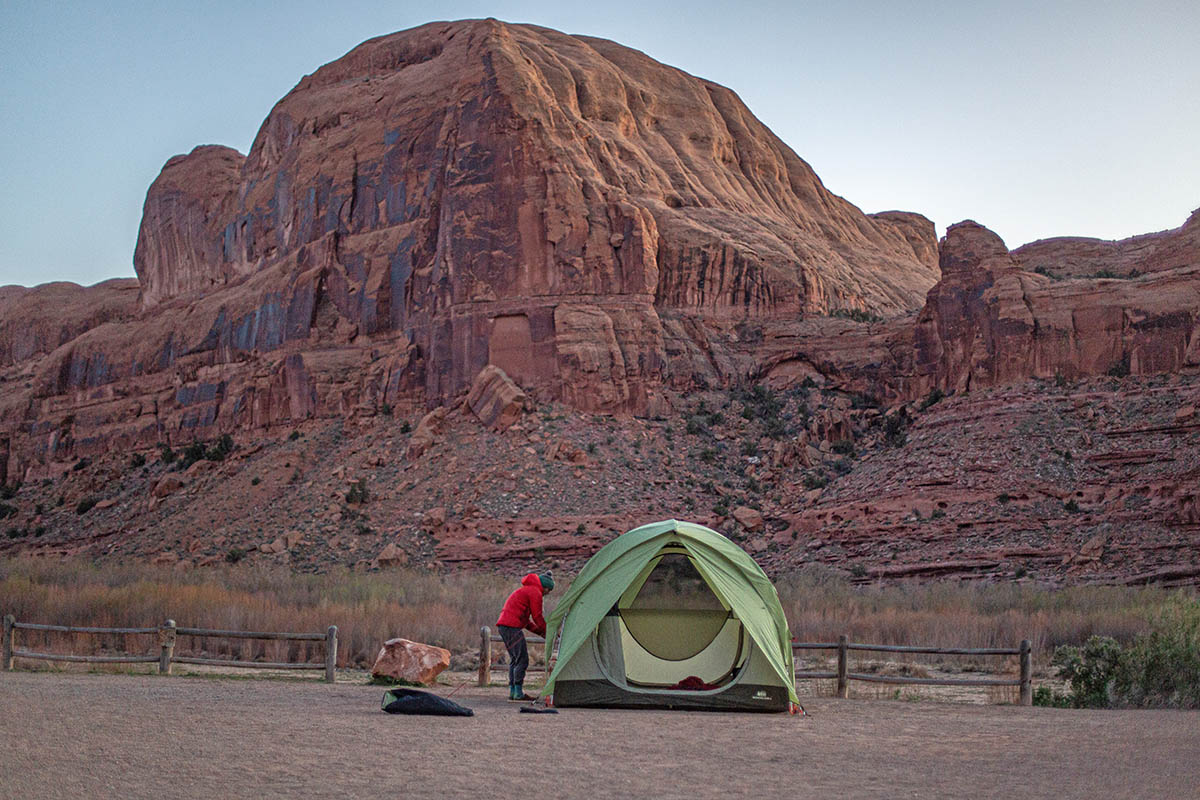
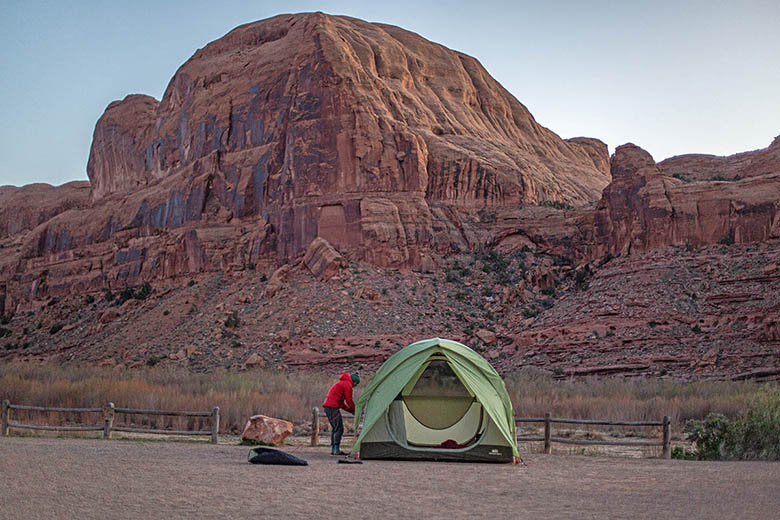
Price: $499
Floor area: 69.4 sq. ft.
Peak height: 75 in.
Weight: 21 lbs. 11 oz.
Capacities: 4P, 6P
What we like: Massive interior, quality materials, and great ventilation.
What we don't: Expensive and not a strong performer in rough weather; we liked the discontinued Kingdom more.
See the REI Co-op Wonderland 4
In a surprising move, REI replaced their popular Kingdom series with the Wonderland line last year. We’ve had a chance to test both the four- and six-person versions (note: The photos below are of the Wonderland 4), and we have to admit that the new tent falls a bit short of its legendary predecessor. Not only is it $100 more expensive, but it has lost useful features like an included vestibule and functional backpack-style stuff bag, and interior storage is worse too. The Wonderland still has strong appeal for families and large groups with a well-built, spacious, and functional design, but REI’s top-end camping tent is no longer a class leader. Below we break down our experiences with the Wonderland. To see how it stacks up to the competition, check out our article on the best camping tents.
Featuring a long and tunnel-like shape, big doors on each end, and a generous 75-inch peak height, the REI Co-op Wonderland 4 Tent is a standout in terms of livability. The pole structure does a great job stretching the walls and giving the tent its upright shape, and the tall height is relatively consistent throughout (something that dome-style tents can’t match). In addition, the Wonderland's two full-size, rounded doors make it extremely easy to get in and out, even with sleeping pads and mats set up inside. This makes it one of the most livable four-person tents on the market, beating out REI’s own single-door Skyward 4 that we also had along on our trip to Utah. It also stacks up well with popular alternatives like The North Face’s Wawona 4 (68-in. peak height) and Marmot’s Limestone 4P (63 in.).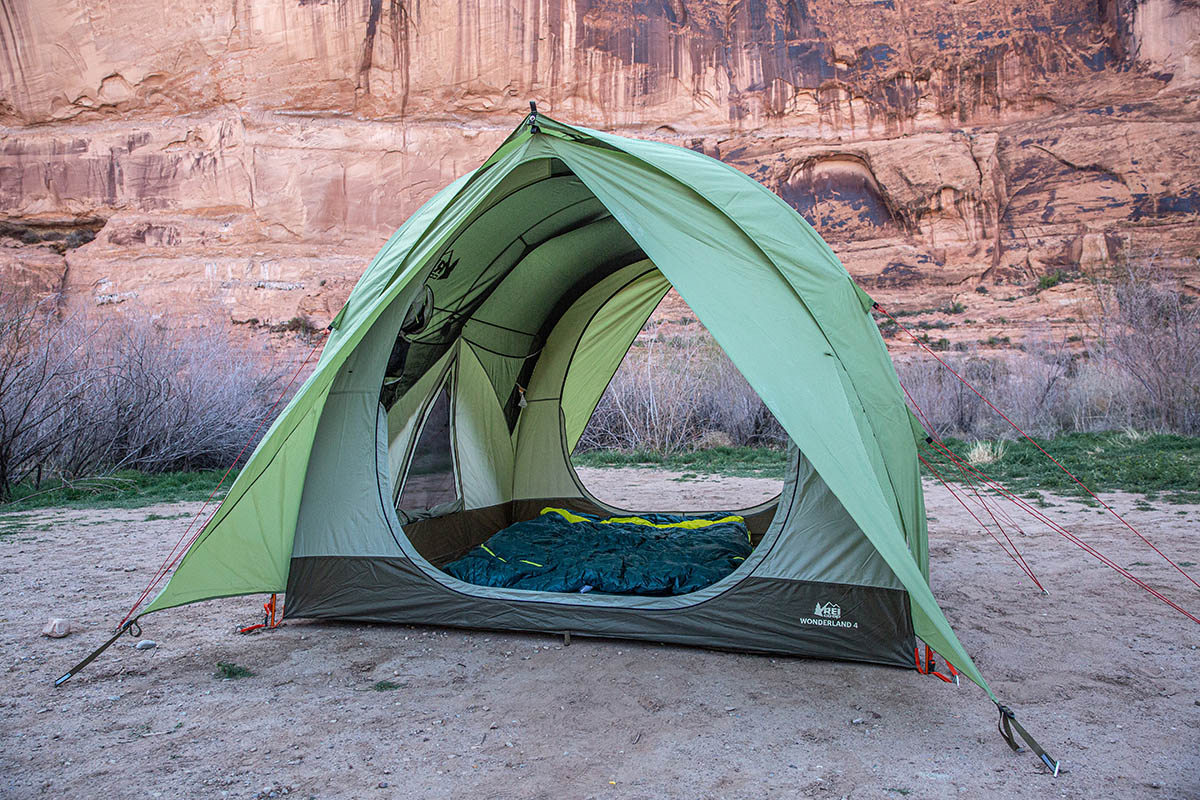
For floor area, the Wonderland 4 is a square shape that measures 99 x 99 inches at the corners (just under its listed 100 x 100 in. measurements). In use, these generous dimensions make it a nice match for two to three adults. We were able to comfortably fit a double-wide sleeping pad (NEMO’s Roamer Double) and a 25-inch-wide camping mat with enough space along the ends to get in and out without having to stand on the pads. As with all camping tents, however, we recommend sizing up if you like having extra space, and a family of four will be better off with the 20-inch-longer Wonderland 6.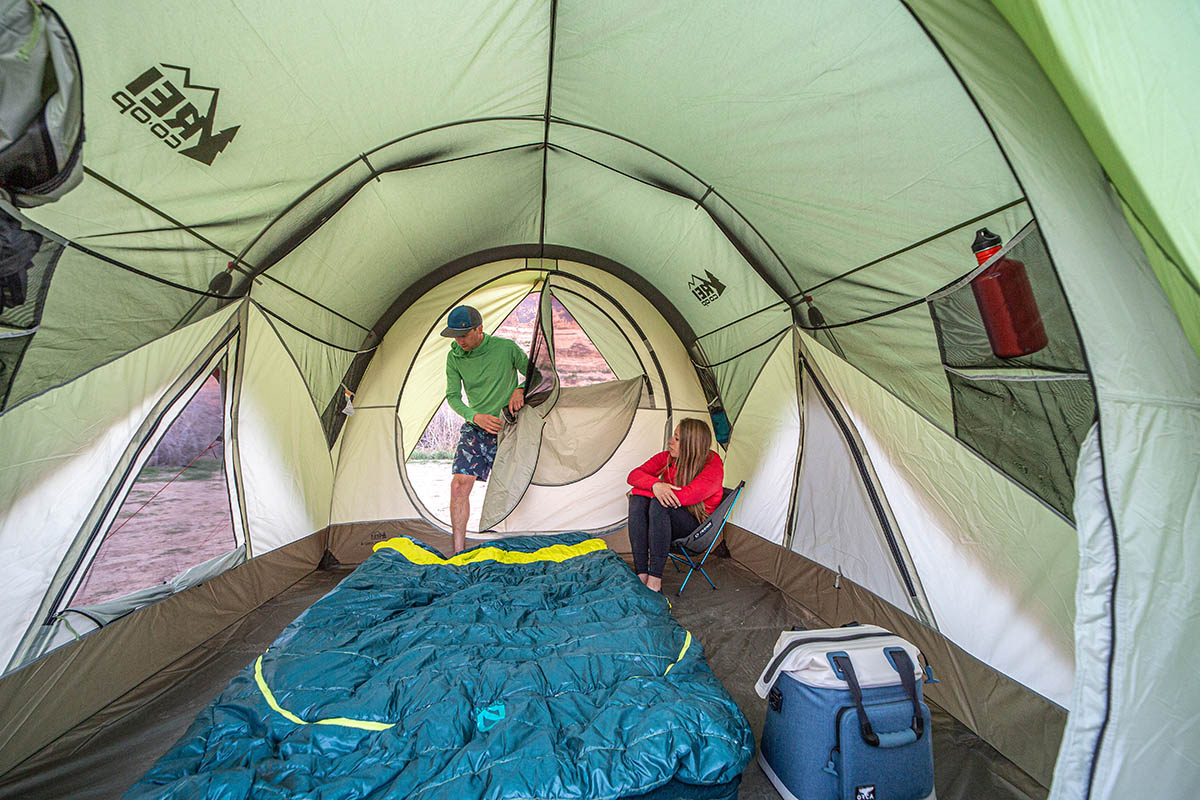
With the redesign, REI addressed one significant complaint about the old Kingdom’s leak-prone roof vents but otherwise didn’t make many substantial improvements. In fact, the Wonderland’s rainfly now offers less overall coverage with minimalist awnings protecting the doors and significant cutouts along each side. To their credit, the awnings are substantial enough to block most rainfall (blowing rain is another story), and the doors have solid fabric covering the mesh and have been reinforced with seam taping (the same goes for the windows along the sides). But the reality is that the Wonderland offers less overall protection than the full-coverage rainflies that are pretty standard in this price class, including what you get with Nemo's Aurora Highrise, Marmot’s Limestone and Halo, and MSR’s Habitude. It’s important to note that purchasing the optional Wonderland Mud Room will boost both protection and storage space considerably, but it'll run you an additional $125.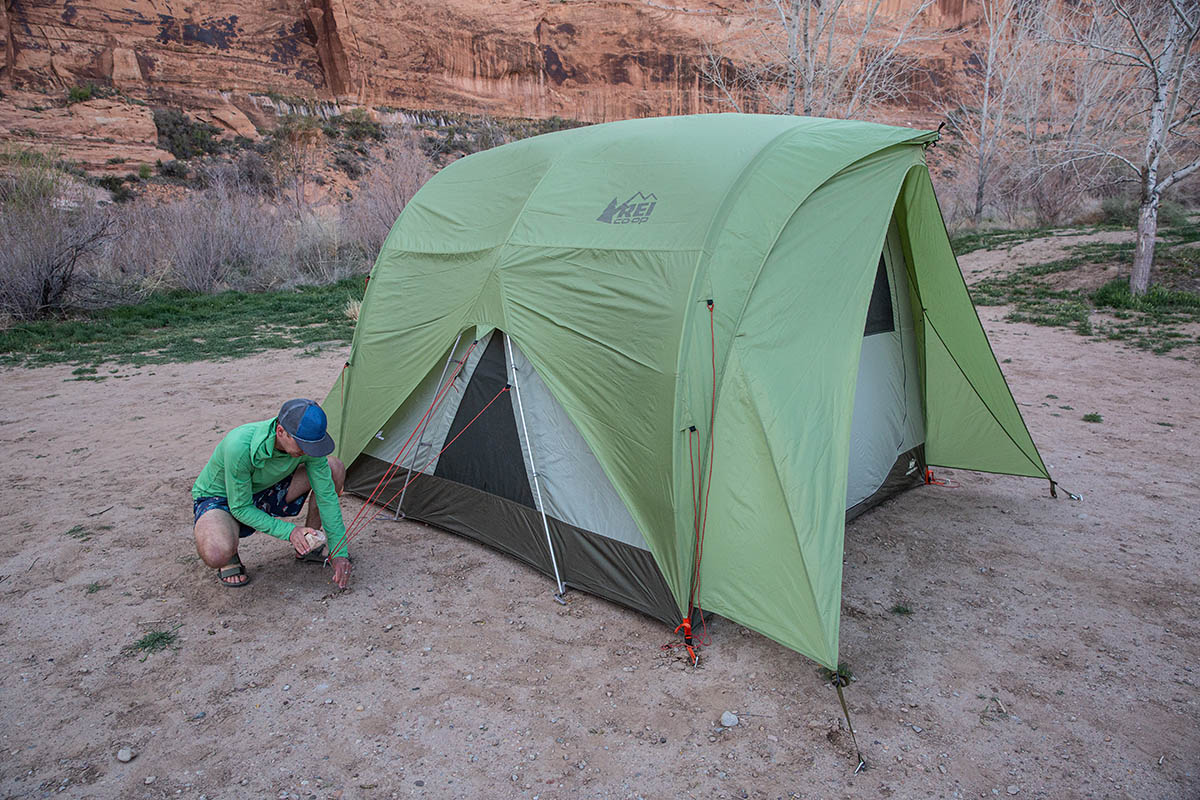
One tradeoff of the Wonderland’s upright profile is that it doesn’t perform well in heavy winds. While the tent is clearly well made and has high-quality and sturdy aluminum poles (as well as a good array of attachment points for guylines), the tall sides simply aren’t as aerodynamic as dome-style designs in rough conditions. To be fair, this likely won’t be an issue for most campers, and the Wonderland proved to be noticeably better in the wind than REI’s cheaper Skyward. But for those who find themselves camping in remote places, camp in all four seasons, or need a very strong design, Cabela’s Alaskan Guide Model, Marmot’s Halo, or REI’s own Base Camp are better options.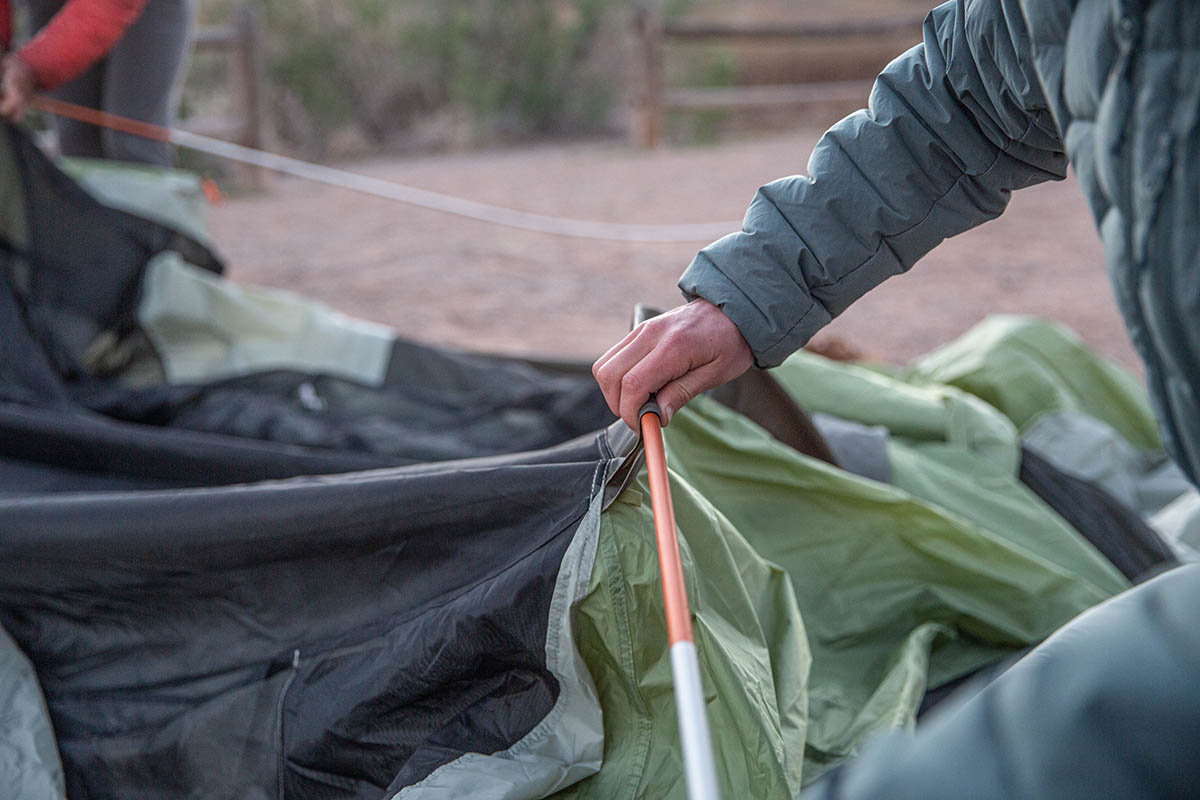
Although the REI Wonderland 4 Tent isn’t the best performer in inclement weather, it's an excellent ventilator. The upper portion of the tent body is made of mesh, and you can unzip the solid fabric covering the top half of each door to expose even more mesh. This is a situation where the awning-style rainfly comes in handy, as you can open up the mesh portion of the doors without compromising protection in light (and not blowing) rainfall—a nice feature in warm and humid conditions. Finally, there are triangular mesh “windows” on each side of the tent that can be zipped open for views or to boost airflow. In the midday heat in Moab, this setup proved to be extremely useful and kept the interior from overheating, even with the fly in place. That said, it’s important to be aware that the exposed mesh can be an entry point for blowing dirt, so you’ll want to be strategic about which windows you open up.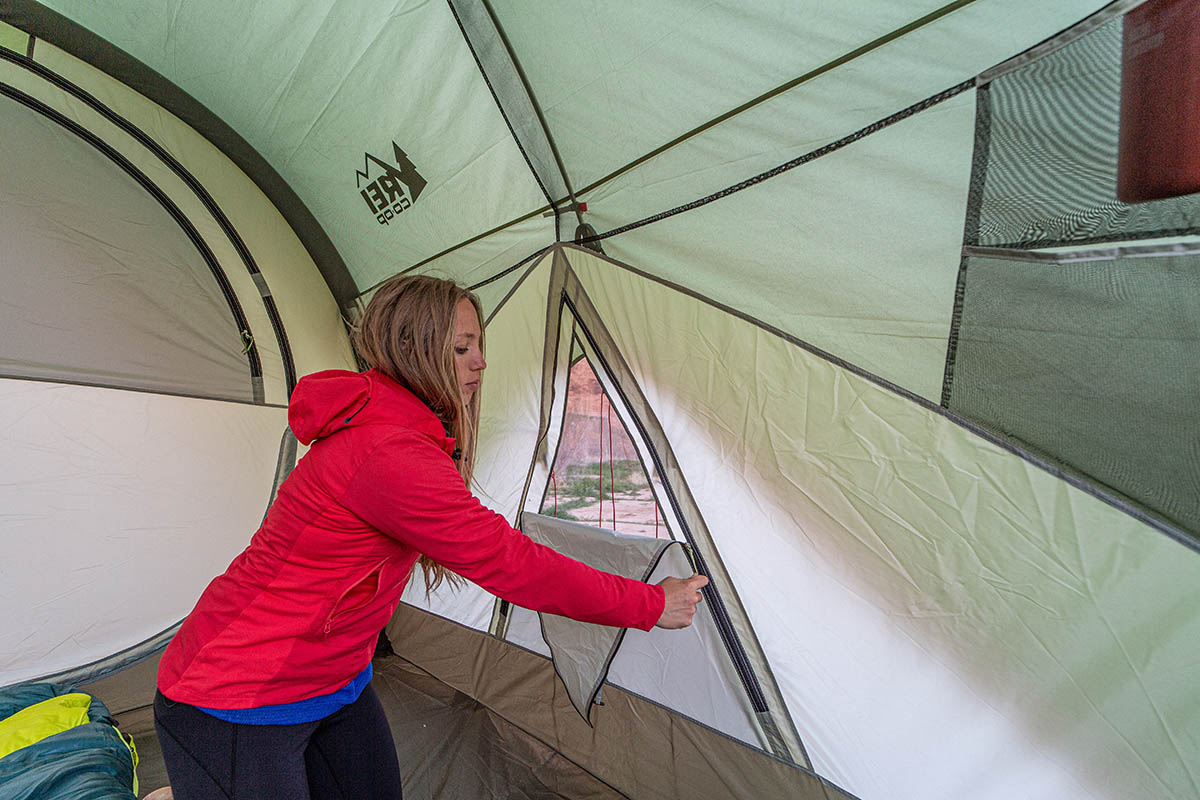
The discontinued Kingdom had some of the best storage and organization on the market with pockets running the entire length of the tent. REI took a simpler approach with the Wonderland 4 and included two pockets stacked vertically at each corner, as well as a hang loop in the middle of the tent for securing a camping lantern. However, while it’s a fair amount of storage at eight pockets in total, they’re positioned too high to access while lying down (a bummer when reaching for a headlamp or lantern in the middle of the night). You also miss out on protected exterior storage unless you spring for the aforementioned Mud Room, which is a sizable upgrade at $125. All told, I’d categorize overall organization as so-so: It’s easy to distribute gear in all of the pockets, but we wish they were placed lower for easier access, plus we’d like an included vestibule at this price point.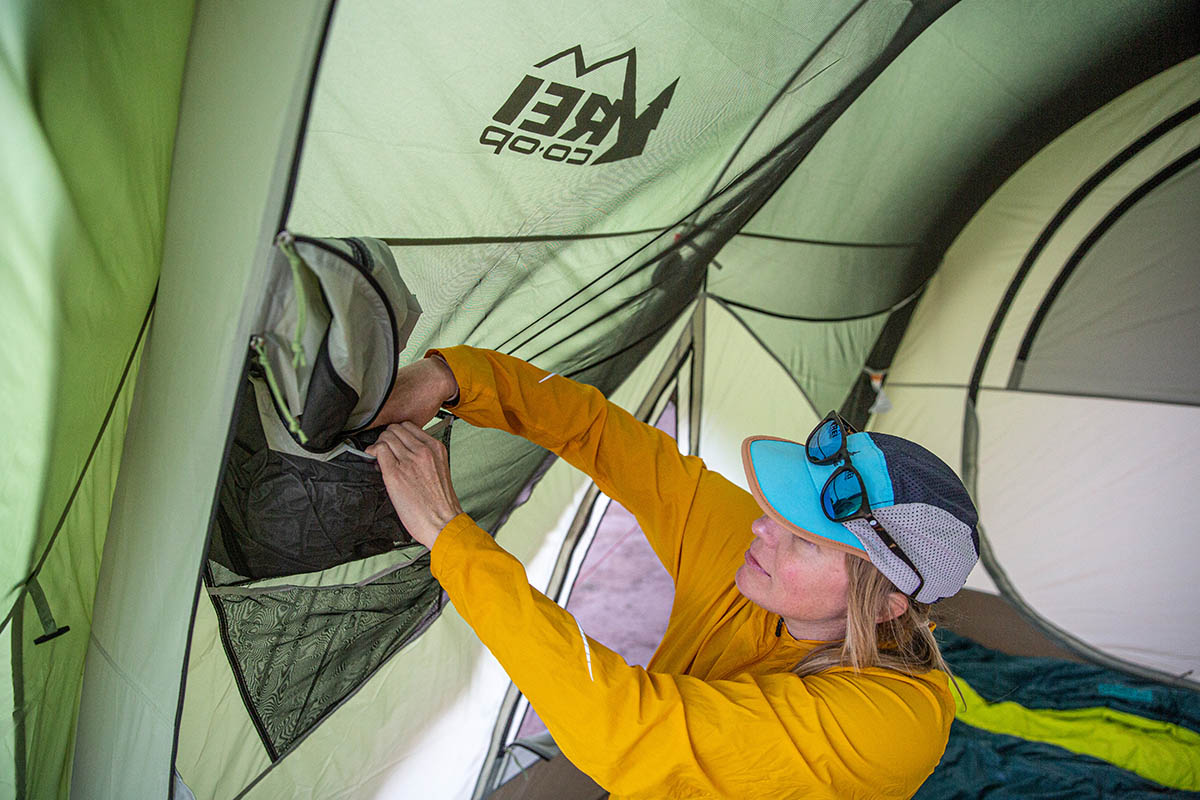
At $499 for the Wonderland 4 and $599 for the Wonderland 6, we set high expectations in terms of quality, and REI delivers on that front. Everything from the substantial aluminum poles to the mesh fabric and zippers are clearly well made and have performed flawlessly thus far. We were also happy to see that the plastic hubs that connect the poles on the sides of the tent are set low and are not under much strain (these hubbed pole systems can be a source of failure).
In addition, there’s quality seam taping along the interior, and the coated 75-denier fly and 150-denier floor are tough and highly resistant to tears and abrasion. We’ve opted against using a footprint with no issues to report thus far, although bringing a ground cloth is a nice way of avoiding damage over the long term (REI sells one for $60, or you can simply make your own). Another nice touch is that REI includes enough stakes (18) and guylines (8) to properly set up the tent in wind and bad weather (tent manufacturers often skimp on the number of pegs).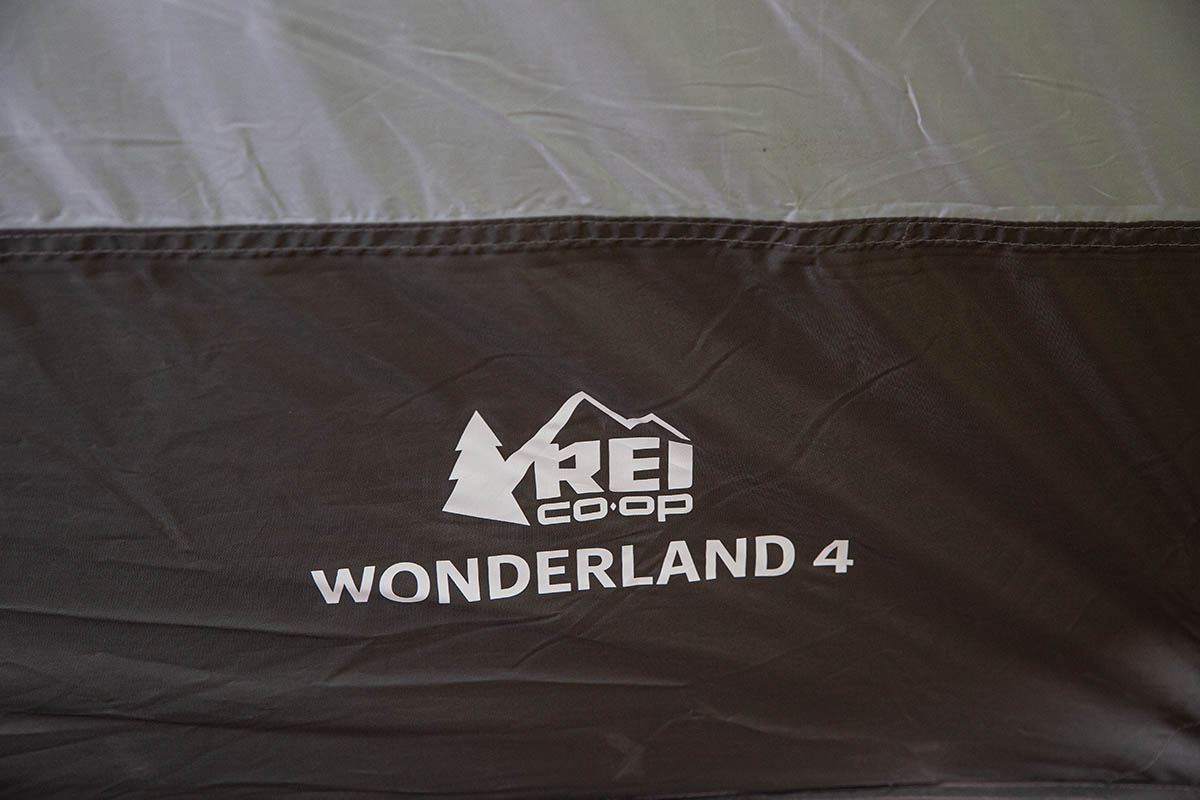
At 21 pounds 11 ounces all in, the Wonderland 4 is one of the heaviest four-person camping tents on the market. To be fair, weight matters a lot less when you’re car camping than backpacking deep in the wilderness, but the heft still is important to factor in if you’ll be walking more than a short distance from your vehicle. For reference, REI’s own Skyward 4 (13 lbs. 11 oz.) and Base Camp 4 (16 lbs. 14 oz.) undercut the Wonderland considerably, as do other popular alternatives like MSR’s Habitude 4 (12 lbs. 10 oz.) and Marmot’s Limestone 4P (11 lbs. 13.6 oz.).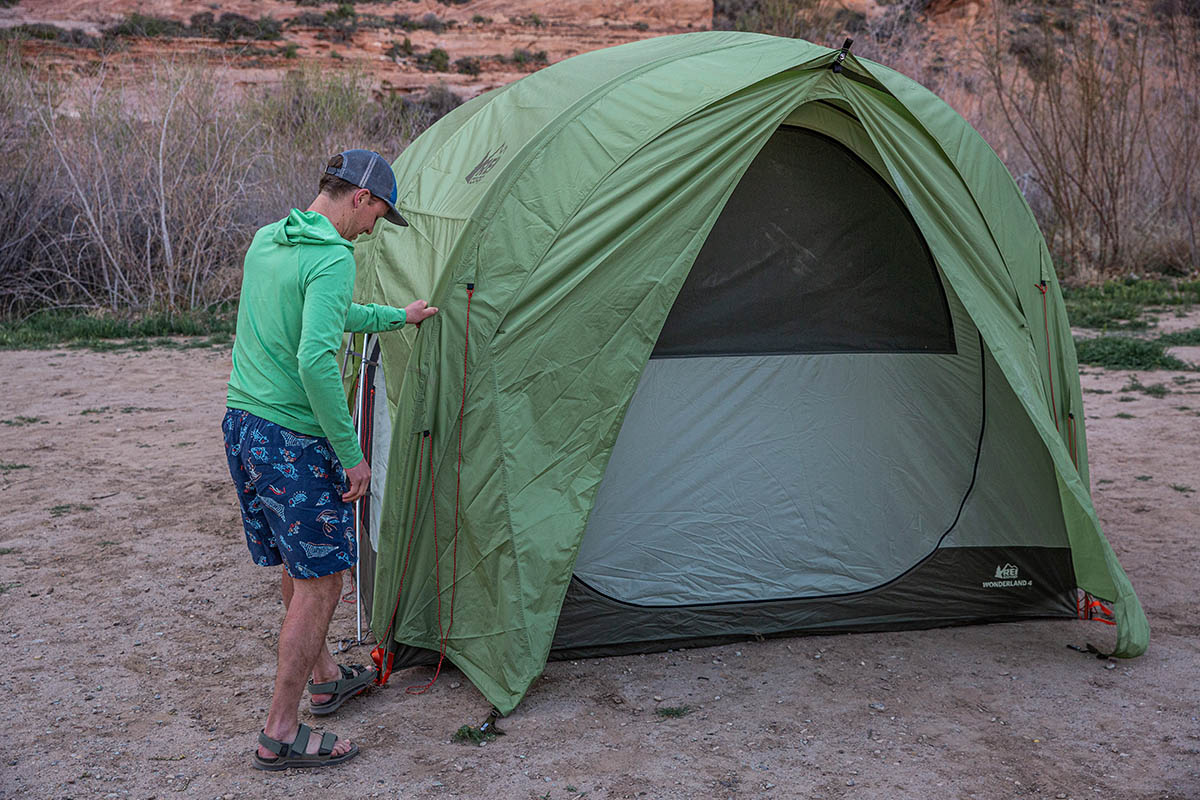
Despite its hefty build, the Wonderland’s packed size (listed at 12 x 32 in.) is reasonable for a camping tent, but the included stuff sack is a disappointment. Not only did REI ditch the superb backpack-style bag of the Kingdom—which had dedicated compartments for the rainfly, tent body, and poles—but the bag itself is small and requires pretty careful packing to fit everything inside. We don’t usually mind the added effort when backpacking (it’s par for the course to save space), but we really value the added convenience of a generous stuff sack when car camping.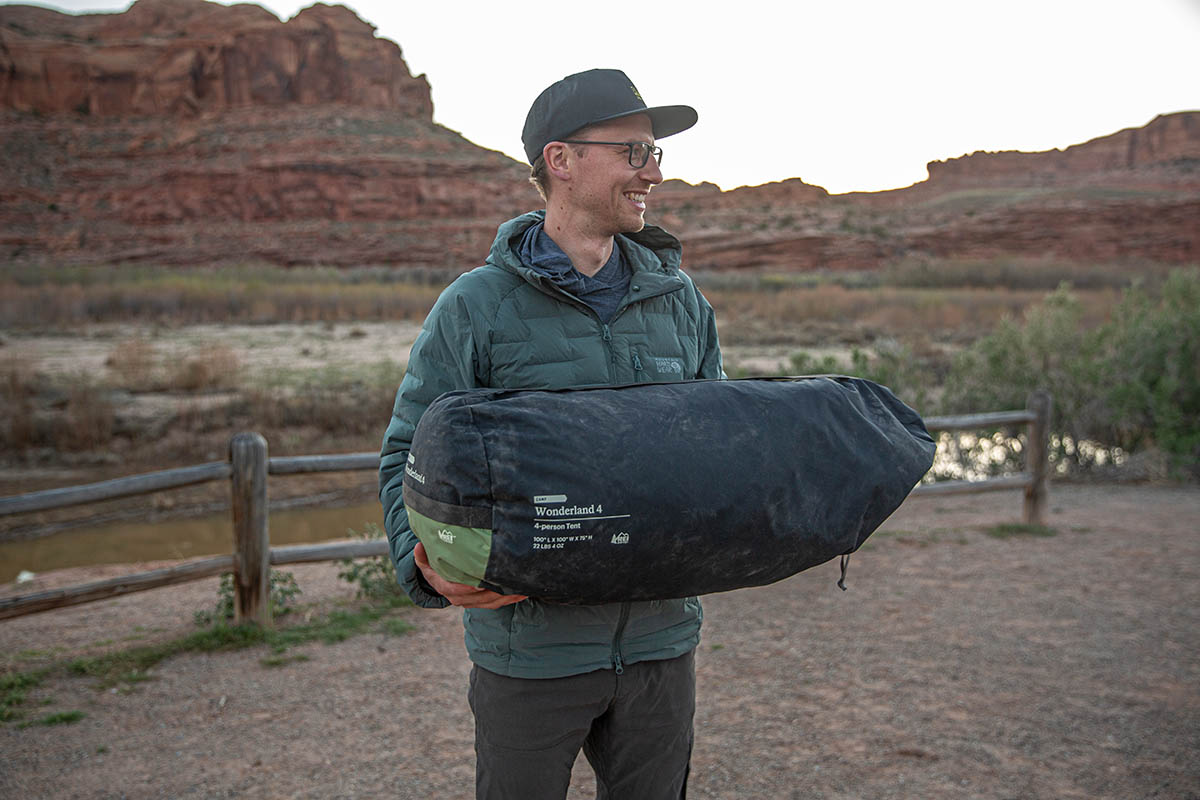
With color-coded aluminum poles and instructions attached to the stuff sack, the REI Wonderland 4 proved to be pretty simple to set up. Our group admittedly struggled a little on the first attempt, which was done in the dark at our campsite in Moab. But once we got the hang of the process—and could easily identify the color coding on the ends of the poles—it proved to be quite intuitive. In fact, it’s possible to set up the tent solo in about 10 minutes—something I was able to accomplish even with some light wind making things a bit more exciting. Considering the sheer size and height of the Wonderland, that’s pretty high praise.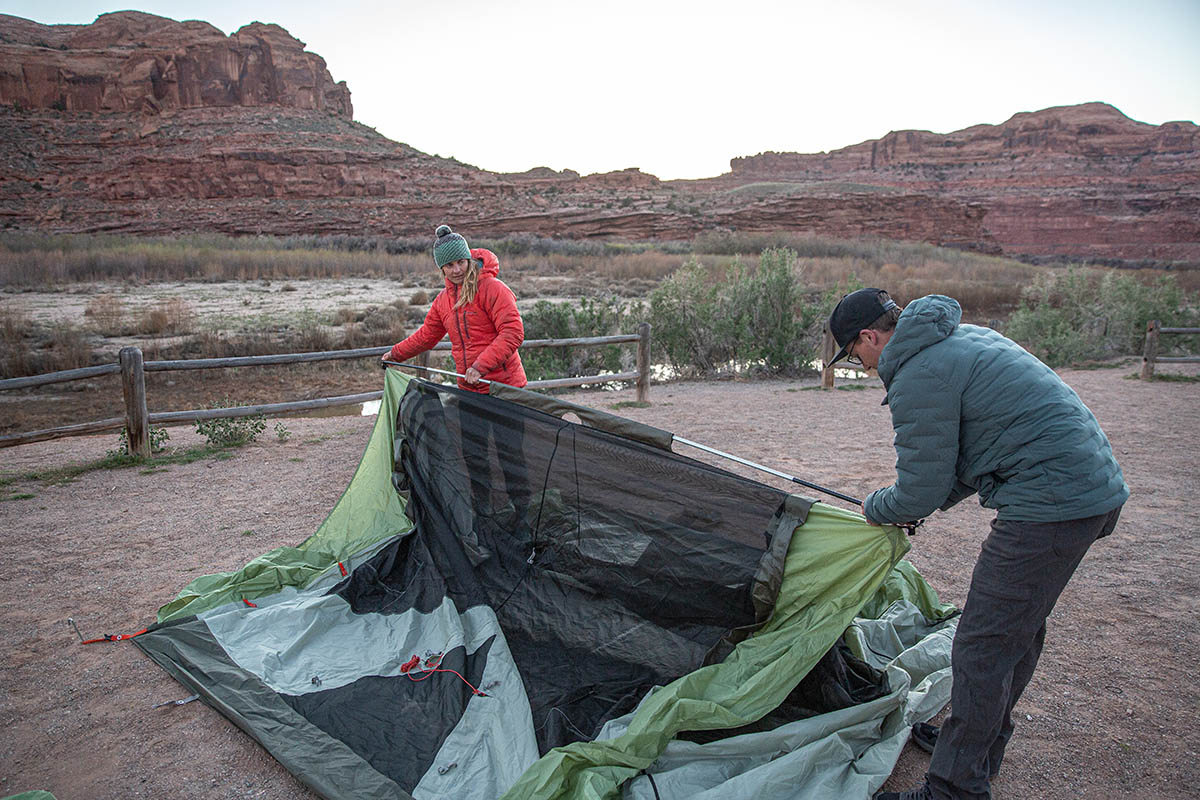
REI is known for their focus on sustainability, and the Wonderland collection follows suit by utilizing solution-dyed mesh. Compared to standard production methods, solution dying requires less water and energy during manufacturing. We do wish they had included other measures like recycled or bluesign-approved materials, but it’s nevertheless a nice update from the discontinued Kingdom.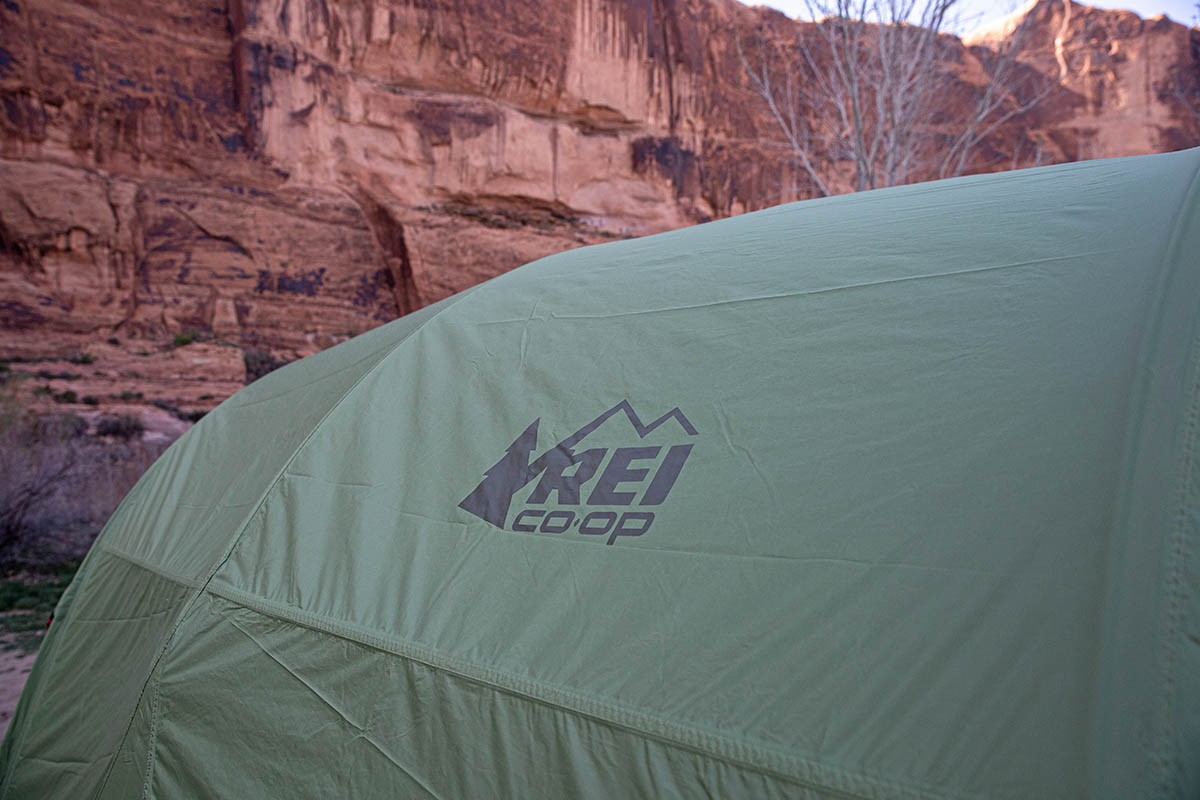
We covered the four-person Wonderland for this review, and we also have experience with the larger six-person variation. For $100 more than the 4P model, the Wonderland 6 adds 13.9 square feet of floor space (83.3 sq. ft. total) and 3 inches of additional headroom (78 in. at its peak). You also get an interior divider wall with a center zipper to create two separate rooms, and weight goes up slightly to 22 pounds 15 ounces. Most other features remain the same, including two doors, tough fabrics on the fly and floor, and an identical pole structure that provides excellent livability for larger groups and families. A final (albeit very niche) option in the new Wonderland lineup is the Wonderland X, which is essentially a customizable version of the four-person model with a clip-in inner tent and separate living area. The system can be configured in several ways for eating, sleeping or hanging out, but it’s eye-wateringly expensive at $1,249 and decidedly overkill for most.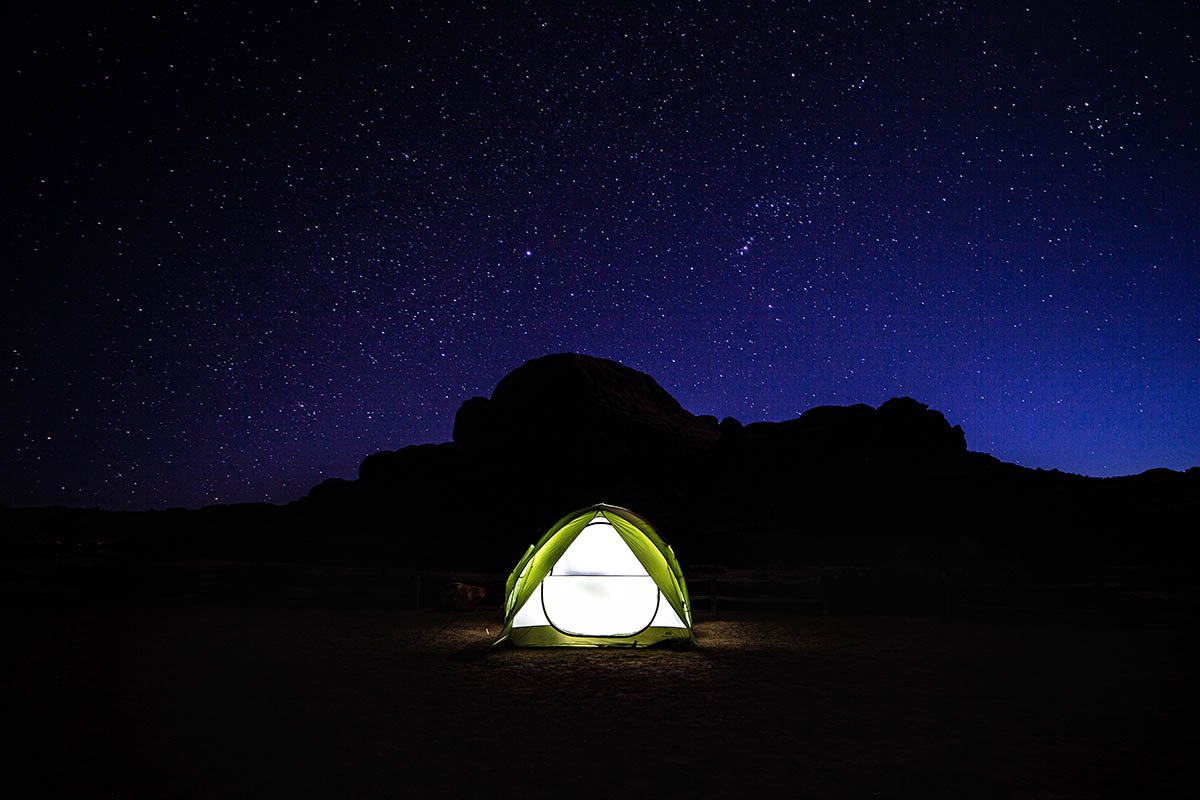
We’ve mentioned the Wonderland Mud Room a few times throughout this review, but here’s the quick summary: Since the Wonderland’s awning-style rainfly provides very limited coverage and no vestibule space, the Mud Room offers a way to boost protection and exterior storage by creating a covered room at the entryway that connects directly to the tent. It’s a fairly steep investment at $125, bringing the overall total up to $624, but you get a generous 56 square feet of vestibule space (the "floor" dimensions are 100 x 77 in.), interior loops to hang gear or wet clothes, and sidewalls that can be unclipped and rolled up to create a sun shelter (the two doors can also be rolled back to boost airflow without heavily impacting protection).
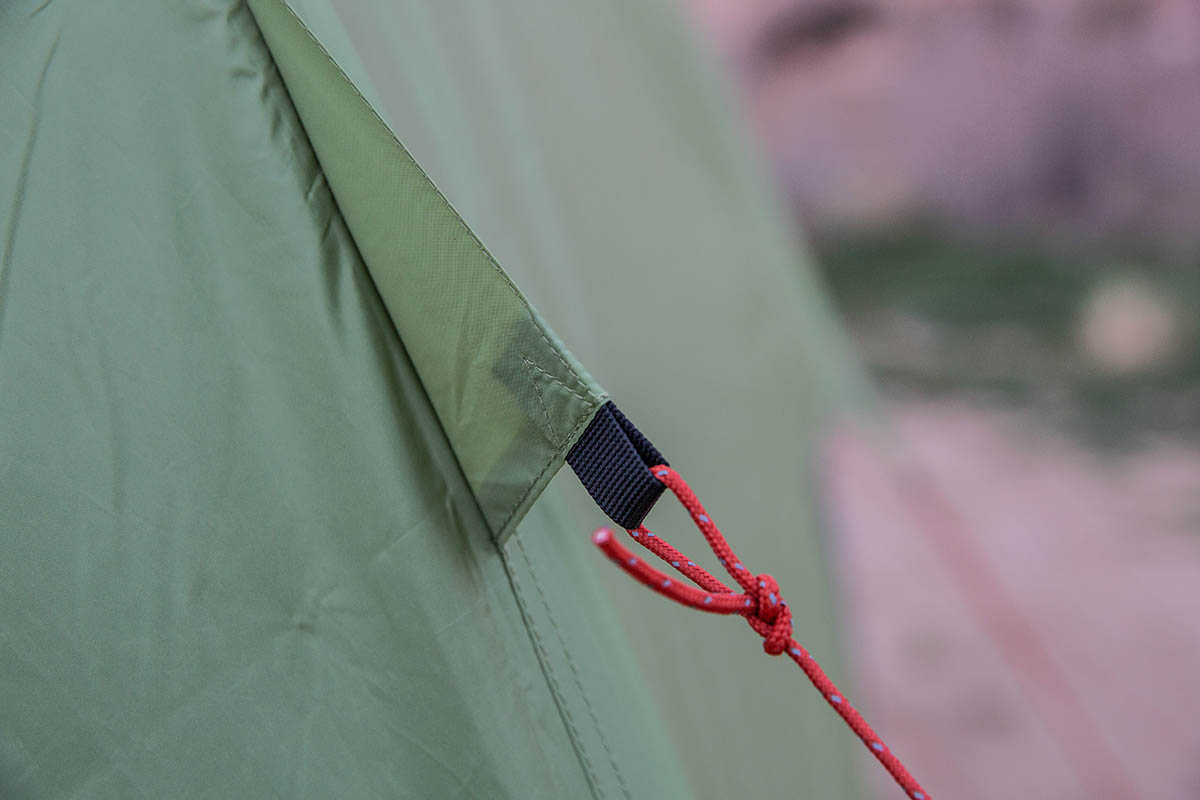
| Tent | Price | Floor | Height | Capacities | Weight | Packed Size | Doors |
|---|---|---|---|---|---|---|---|
| REI Co-op Wonderland 4 | $499 | 69.4 sq. ft. | 75 in. | 4P, 6P | 21 lbs. 11 oz. | 12 x 32 in. | 2 |
| REI Co-op Skyward 4 | $299 | 60 sq. ft. | 78 in. | 4P, 6P | 13 lbs. 11 oz. | 9.8 x 27.5 in. | 1 |
| REI Co-op Base Camp 4 | $449 | 59.7 sq. ft. | 60 in. | 4P, 6P | 16 lbs. 14 oz. | 10 x 20 in. | 2 |
| Big Agnes Bunk House 4 | $600 | 58 sq. ft. | 72 in. | 4P, 6P | 16 lbs. 3 oz. | 16.5 x 26.5 in. | 2 |
| Marmot Limestone 4P | $429 | 59.2 sq. ft. | 63 in. | 4P, 6P | 11 lbs. 13 oz. | 10.4 x 24.4 in. | 2 |
| MSR Habitude 4 | $600 | 62.5 sq. ft. | 73 in. | 4P, 6P | 12 lbs. 10 oz. | 9 x 23 in. | 1 |
REI’s Wonderland sits at the top of their camping tent lineup both in terms of price and livability, but you can save considerably with their Skyward 4 Tent, which replaced their popular Grand Hut line in 2022. For $200 less than the Wonderland 4, the Skyward 4 is significantly lighter and easier to haul around at 13 pounds 11 ounces but maintains great all-around livability with a 78-inch peak height (3 in. taller than the Wonderland) and generous 60-square-foot floor area. However, it only has one door, and while the rainfly does cover the entryway and create a 19.5-square-foot vestibule space, it leaves three single-wall sides exposed to the elements. Like the Wonderland, the Skyward’s stuff sack is also relatively small and requires diligent folding and rolling to fit all of the components. In the end, unless the lower weight (and lower price) is appealing to you, we consider the Wonderland the more competitive and well-rounded design from REI (for more, see our Skyward 4 review).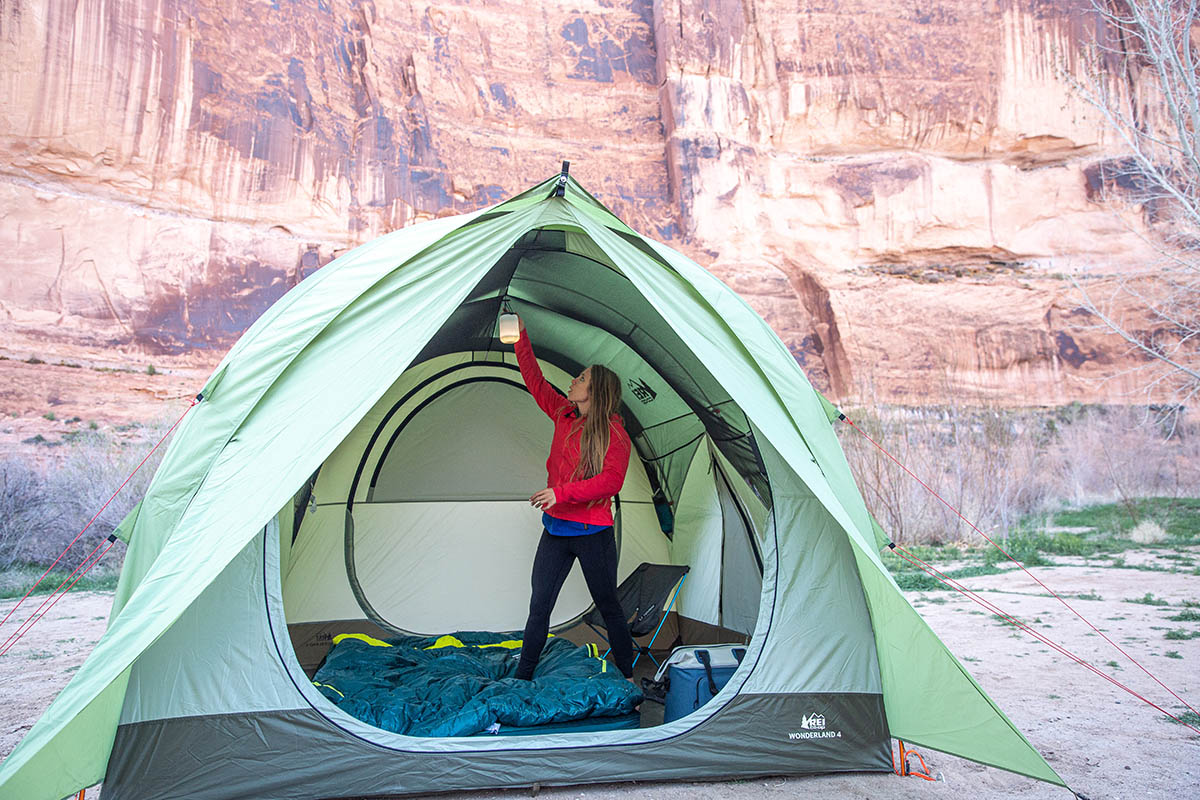
For those who don’t mind getting out in inclement conditions, REI’s own Base Camp 4 is the most weather-ready option in their collection. Unlike the long and tunnel-like Wonderland, the Base Camp has a traditional dome-style shape that stands up much better to strong winds. You also get a full-coverage rainfly that translates to far better protection in heavy and blowing rain. However, while overall livability is good with a reasonably spacious 59.7-square-foot floor area and two wide, rounded doors, the Base Camp feels noticeably less roomy due to the shorter 60-inch peak height and lack of vertical walls. It also uses less mesh and doesn’t ventilate as well as the Wonderland as a result. In the end, a final decision between the two will come down to how you prioritize protection (the Base Camp wins out) versus features and livability (the Wonderland gets the edge).
Outside of REI’s lineup, Big Agnes’ Bunk House 4 stands out for its effective balance of interior space and wet-weather protection. Stacked up against the Wonderland, the Bunk House is a little less roomy with 58 square feet of floor area and a 72-inch peak height, but it’s lighter by around 6 pounds, has a full-coverage rainfly for added protection in a storm (bonus: The fly can be pitched on its own as a minimalist shelter), and offers 49 square feet of total vestibule space to store gear. Big Agnes didn’t skimp on the details either, including useful additions like an awning-like door that can be staked out as a sunshade, backpack-style stuff sack that makes it easier to haul the tent to and from camp, and 16 total interior pockets. The Bunk House does cost $100 more than the Wonderland, but most dedicated campers will likely find the investment worth it (especially if you anticipate adding the $125 Wonderland Mud Room). 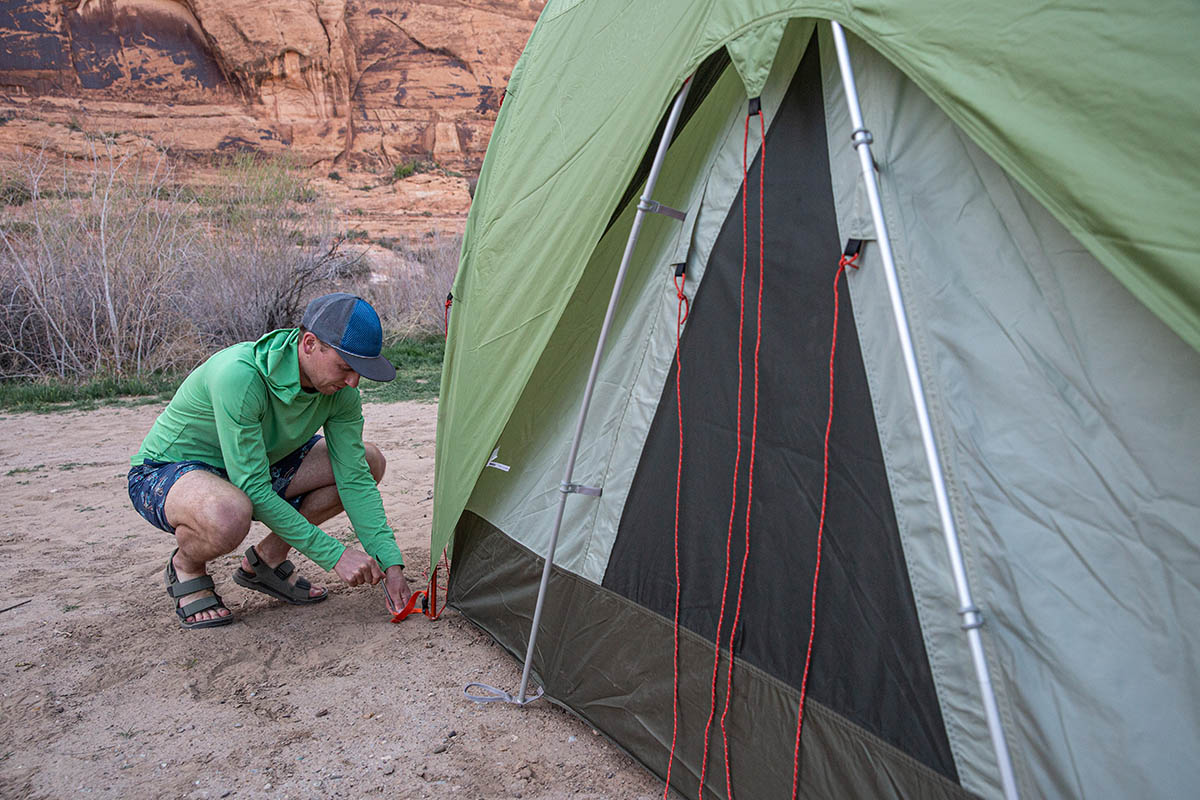
Next up is Marmot’s popular Limestone 4P. For a reasonable $429 ($70 less than the Wonderland 4), the Limestone boasts ample sleeping space for four (59.2 sq. ft.), is easy to pitch, and offers better weather resistance (especially in strong winds) with a full-coverage rainfly and taut DAC pole design. You do sacrifice some headroom with the 63-inch peak height, but the Marmot’s poles do a decent job of stretching the walls outward to create a roomy-feeling interior. Like the Wonderland, the Limestone is also a good ventilator with a mesh-heavy construction and well-placed vents to keep air flowing (although there aren’t any windows). All in all, it’s hard to beat the Wonderland’s tall and tunnel-like build, but the Limestone feels more well balanced to us.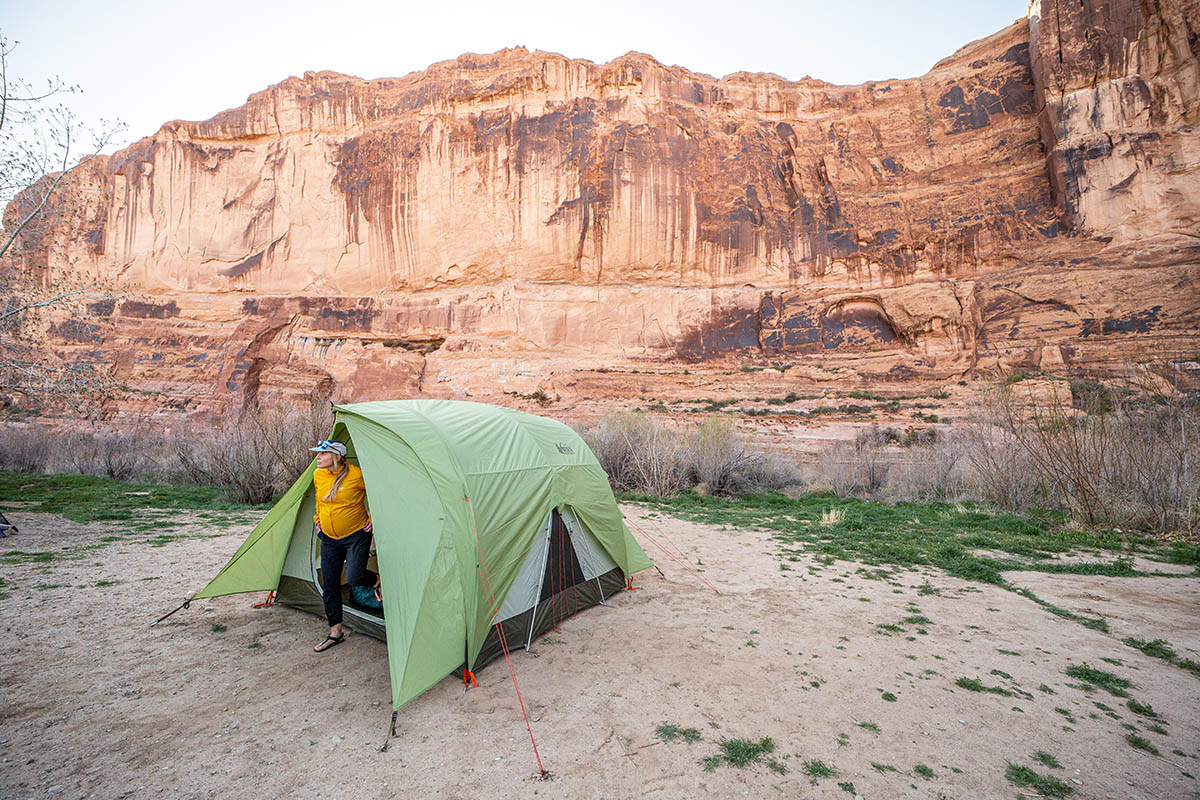
The livability of the REI Wonderland is hard to beat, but MSR's Habitude 4 comes pretty darn close. Like the REI, the Habitude is a great pick for families with a standing-height (73-in.) interior, generous floor space (62.5 sq. ft.), and functional feature set including several interior pockets, hang loops, and even a built-in porch light for more easily entering and exiting in the dark. As we’ve come to expect from MSR, the Habitude is also well built with sturdy poles and a polyurethane coating for added protection against moisture, and it’s noticeably more weather-ready with a full-coverage rainfly. It’s also lighter than the Wonderland by around 9 pounds, although this is largely due to the thinner fabrics (68D floor and fly) and single door. Both are massive and undeniably roomy options for groups and families, but the Wonderland’s double-door layout and $101-cheaper price tag will likely be enough to sway most.
Editor’s note: We usually provide a live price comparison table below our outdoor gear reviews, but the Wonderland is sold exclusively by REI Co-op. You can see the Wonderland 4 Tent page here and support us in the process. Thanks!